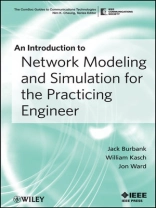This book provides the practicing engineer with a concise listing of commercial and open-source modeling and simulation tools currently available including examples of implementing those tools for solving specific Modeling and Simulation examples. Instead of focusing on the underlying theory of Modeling and Simulation and fundamental building blocks for custom simulations, this book compares platforms used in practice, and gives rules enabling the practicing engineer to utilize available Modeling and Simulation tools. This book will contain insights regarding common pitfalls in network Modeling and Simulation and practical methods for working engineers.
Table of Content
Preface vii
Acknowledgments ix
About the Authors xi
1. Introduction 1
1.1 Advantages and Disadvantages of Modeling and Simulation
6
1.2 Comparison of ‘Homebrew’ Models and Simulation
Tools 8
1.3 Common Pitfalls of Modeling and Simulation and Rules of
Thumb 9
1.4 An Overview of Common M&S Tools 16
1.5 An Overview of the Rest of This Book 18
2. Modeling and Simulation for RF Propagation 20
2.1 The Fading Channel 22
2.2 The ITU M.1225 Multipath Fading Profi le for Mobile Wi MAX
38
2.3 Practical Fading Model Implementations–Wi MAX Example
42
2.4 RF Propagation Simulators 45
2.5 Propagation and Fading Simulations–Lessons Learned
48
3. Physical Layer Modeling and Simulation 51
3.1 Incorporating Interference into a Model 52
3.2 The Importance of a Preamble 59
3.3 Practical Wireless PHY Model Implementations 62
3.4 Wireless Network Simulation Lessons Learned and Common
Pitfalls–PHY Layer 69
4. Medium Access Control Modeling and Simulation 72
4.1 Modeling and Simulation of Wired MACs 73
4.2 Wireless Network MAC Simulation 78
4.3 Practical MAC Model Implementations 90
4.4 Network Simulation Lessons Learned and Common
Pitfalls–MAC Layer 92
5. Modeling and Simulation for Higher Layer Protocols
97
5.1 Network Layer 97
5.2 Transport and Application Layers 102
5.3 Example of Higher Layer Modeling: Transport Layer
Performance Analysis 105
5.4 Example of Higher Layer Modeling: Detailed Network
Layer Modeling 109 6. Hardware-in-the-Loop Simulations
114
6.1 Advantages and Disadvantages of HITL Approaches 118
6.2 Network M&S HITL Approaches 120
6.3 HITL Examples 126
6.4 Common Pitfalls for HITL Approaches 139
6.5 Network-Layer HITL-Ready Network Simulation Platforms
139
6.6 HITL Conclusion 142
7. Complete Network Modeling and Simulation 143
7.1 Complete Network M&S Platforms 145
7.2 IEEE HLA (1516) 145
7.3 Complete Network Simulation Examples 172
8. Other Vital Aspects of Successful Network Modeling and
Simulation 180
8.1 Verifi cation and Validation 180
8.2 Data Visualization and Interpretation 185
9. Network Modeling and Simulation: Summary 186
References 188
Index 196
About the author
Jack L. Burbank leads the Wireless Networking section within
the Communications and Network Technologies group of The Johns
Hopkins University Applied Physics Laboratory (JHU/APL). Mr.
Burbank is an expert in the areas of wireless networking and
modeling and simulation, focusing on the application and evaluation
of wireless networking technologies to the military context. His
team of network engineers at JHU/APL participates within the
Internet Engineering Task Force (IETF) and the IEEE 802 standards
organization. Mr. Burbank is a professor of networking and
telecommunications in The Johns Hopkins University Part-Time
Engineering Program, and is a member of the IEEE and ASEE.
William T. Kasch received a B.S. in Electrical
Engineering at the Florida Institute of Technology in 2000 and an
M.S. in Electrical and Computer Engineering at the Johns Hopkins
University in 2003. His interests include various aspects of
wireless networking, including MANET, IEEE 802 technology, and
cellular. He participates actively in both the IEEE 802 standards
organization and the Internet Engineering Task Force.
Jon R. Ward works in the wireless networking section of
the communications and networking technology (VCT) group at T he
Johns Hopkins University Applied Physics Laboratory (JHU/APL) in
Laurel, MD. He has worked projects focusing on network design and
interference testing of standards-based wireless technologies such
as IEEE 802.11, IEEE 802.15.4, and IEEE 802.16.












